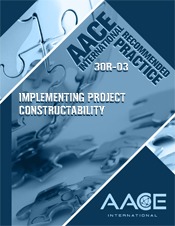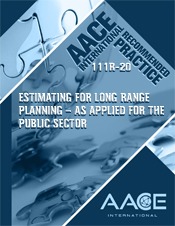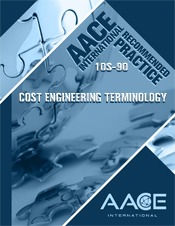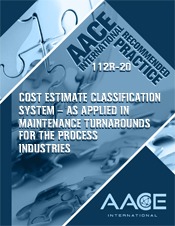New and Revised Recommended Practices
Visit https://web.aacei.org/resources/publications/recommended-practices to download, or you may find them in the Virtual Library or the Online Store.

30R-03: Implementing Project Constructability
REVISED (March 19, 2021)
MEMBER DOWNLOAD | NON-MEMBER PURCHASE
As a recommended practice (RP) of AACE International, Implementing Project Constructability provides guidelines for developing and implementing constructability programs in all the phases of a project’s life cycle. This document is intended to provide a guideline, not a standard.
Constructability is the integration of construction expertise into all phases of the project to benefit cost, schedule, quality, and overall project objectives. The successful use of construction knowledge and expertise increases the probability of project success. Constructability reviews (CRs) should be conducted at key points in the project life cycle: in the planning phase, early in the design phase, prior to the procurement phase and again prior to the mobilization phase for construction. CRs should hold true to the designer’s intent, and the design concept is easiest molded to good constructability early in the design phase.
Constructability, as addressed in this RP, is applicable to projects in any industry in any location (e.g., architectural, process plant, transportation, utilities, offshore, etc.) that include construction work of any scope. In total cost management (TCM), constructability is one of many value improving practices (VIPs) such as manufacturability analysis; reliability, availability and maintainability (RAM) analysis; and so on. Constructability is also useful as a risk management practice that supports risk mitigation. However, these other VIPs and risk management practices are not directly included in this RP.
AACE is not the sole or even primary steward of recommended constructability practice; there are several leading organizations included in the reference section. However, constructability is a skill and knowledge area of cost engineering because, as a VIP, constructability practices require the assessment of cost, schedule, risks, uncertainties and other project attributes for which AACE is the leading organization. This RP highlights the role of cost engineering in the practice.
This RP will discuss how to implement a constructability program in order to maximize the positive impact on the project. It also provides project examples illustrating the success of those properly implemented efforts. Integrating constructability into project plans can result in better safety, lower costs, better productivity, earlier completion and start-ups for ultimately better projects.
Contributors:
March 19, 2021 Revision:
Dr. Douglas D. Gransberg, PE (Primary Contributor)
Dan Melamed, CCP EVP FAACE (Primary Contributor)
Edward E. Douglas, III CCP PSP FAACE Hon. Life
Larry R. Dysert, CCP CEP DRMP FAACE Hon. Life
Dean L. Hammonds
Dr. Randy R. Rapp, PE CCP

111R-20: Estimating for Long-Range Planning – As Applied for the Public Sector
NEW (March 19, 2021)
This recommended practice (RP) of AACE International identifies special considerations that apply when estimating project costs for long-range strategic asset planning, including documenting and communicating the estimate basis. The strategic asset planning that is specifically addressed by this RP supports long-range planning for public sector organizations or similar entities that is required in order for them to better accomplish their objectives. This includes estimating as well as communicating needs and concepts that may pre-date the creation, existence, or emergence of an asset by many years, such as planning for future capacity/infrastructure. These estimates are prepared as planning-level predictions for facilities that may be constructed 10-50+ years in the future. These extreme front-end predictions are necessary for public sector organizations to determine their financial and capital strategies often decades in advance.
These highly conceptual estimates may be revisited periodically during the extended planning-level process. There is often an anchoring effect, i.e., decision-makers are biased towards initial cost estimates prepared at the beginning of a long-range planning estimating process. Subsequent cost analyses are often based on and compared to the initially prepared long-range planning estimate, sometimes ignoring significant changes in scope or strategies, and without adequate consideration of technology change and escalation over time.
These long-range planning estimates are differentiated from traditional AACE International Class 5 estimates for a near-term project where the accuracy range of -20/-50 percent to +30/+100 percent may be sufficient. Long-range planning estimates are prepared for potential facilities within a 10-50+ year strategic asset planning timeframe. It must be acknowledged that the long-range planning estimate is unlikely to be accurate, and the original scope may not be representative of the final solution and associated costs. Unpredictable scope and risk challenges over the extended long-range planning timeframe include economics, technology, availability of resources, critical infrastructure, population dynamics, regulations, organizational and asset resiliency, climate, energy, and natural influences. Clearly, costs are affected by many factors in addition to escalation.
This RP will identify special considerations and define the required project documentation and management communication necessary to provide stakeholders and end-users with clear understanding of costs and associated risks at any point of estimating process for long-range planning in order to convey the story of scope progression and corresponding costs and risks. It will examine estimating for long-range asset planning not at a point in time but as a developing portfolio of cost, best identified as an AACE International Unclassified / Class 10 estimate.
Contributors:
Paul Galeno (Primary Contributor)
Lisa M. Taylor (Primary Contributor)
Gregory Brink
Larry R. Dysert, CCP CEP DRMP FAACE Hon. Life
Crystal Fleet
John K. Hollmann, PE CCP CEP DRMP FAACE Hon. Life
Douglas W. Leo, CCP CEP FAACE Hon. Life
Dan Melamed, CCP EVP FAACE
As a recommended practice (RP) of AACE International, the Cost Estimate Classification System provides guidelines for applying the general principles of estimate classification to project and maintenance turnaround cost estimates (i.e., cost estimates that are used to evaluate, approve, and/or fund projects or turnarounds). The Cost Estimate Classification System maps the phases and stages of cost estimating together with a generic scope definition maturity and quality matrix, which can be applied across a wide variety of industries and scope content.
This recommended practice provides guidelines for applying the principles of estimate classification specifically to maintenance turnarounds for the process industries (A turnaround (in the context of the process industries) is defined here as a planned, periodic shutdown (total or partial) of a process unit or plant to perform maintenance, overhaul and repair operations and to inspect, test and replace process materials and equipment. (Adapted from API definition.). It supplements the generic cost estimate classification RP 17R-97 by providing:
- A section that further defines classification concepts as they apply to turnarounds in the process industries.
- A chart that maps the extent and maturity of estimate input information (turnaround preparation & planning definition deliverables) against the class of estimate.
As with the generic RP, the intent of this document is to improve communications among all the stakeholders involved with preparing, evaluating, and using turnaround cost estimates specifically for the process industries.
The overall purpose of this recommended practice is to provide the process industry with a turnaround definition deliverable maturity matrix that is not provided in 17R-97. It also provides an approximate representation of the relationship of preparation & planning input data and scope deliverable maturity to the estimate accuracy and methodology used to produce the cost estimate. The estimate accuracy range is driven by many other variables and risks, so the maturity and quality of the scope definition available at the time of the estimate is not the sole determinate of accuracy; risk analysis is required for that purpose.
This document is intended to provide a guideline, not a standard. It is understood that each enterprise may have its own project and estimating processes, terminology, and may classify estimates in other ways. This guideline provides a generic and generally acceptable classification system for the process industries that can be used as a basis to compare against. This recommended practice should allow each user to better assess, define, and communicate their own processes and standards in the light of generally accepted cost engineering practice.
Contributors:

10S-90: Cost Engineering Terminology
NEW AND REVISED TERMS (March 23, 2021)
(REVISED)
Constructability –
Old Definition (3): The extent to which the design of a structure or system facilitates ease of construction, subject to the overall requirements for the completed form. The optimum use of construction knowledge and experience in planning, engineering, procurement and field operations to achieve the overall objective. (June 2007).
Revised Definition (3): The ease with which a project can be built, based upon the extent to which the design of a structure or system subject to the overall requirement(s) for its completed form. Based upon the optimum use of construction knowledge and experience in planning, engineering, procurement and field operations to achieve the overall objective. (March 2021)
(NEW)
COST ESTIMATING METHODOLOGY, DETERMINISTIC – A methodology where the independent variables (e.g., the quantity of an item or the unit cost of an item) used in a cost estimating relationship (algorithm) are more or less a definitive measure for the item being estimated. (March 2021)
(NEW)
COST ESTIMATING METHODOLOGY, STOCHASTIC – A methodology where the independent variables used in a cost estimating relationship are generally something other than a direct measure of the item being estimated. The cost estimating relationship may be based on factors, metrics, and values that are associated with some level of randomness, and which may be based on models or probabilistic assessments. (March 2021)
(NEW)
Discovery Work – In the context of maintenance turnarounds, work that is discovered during the turnaround execution window, when equipment is opened and inspected. (March 2021)
(NEW)
Emergent Work – In the context of maintenance turnarounds, this is work that arises after scope freeze and before the start of shutdown. It usually arises because an item has unexpectedly failed in service or broken down and now requires repair. However, it inevitably sometimes includes forgotten or overlooked work; work that should have been known before scope freeze, but which was somehow missed off the original scope due to a human or system error. (March 2021)
(NEW)
Key PROJECT Performance Parameter – A vital characteristic, function, requirement, or design basis, that if changed, would have a major impact on the facility or system performance, scope, schedule, cost and/or risk, or the ability of a project to meet its objectives. (March 2021)
(NEW)
Premise document – In the context of maintenance turnarounds this refers to a scoping document produced in the early stages of preparation & planning for a turnaround. It explains the reasons for holding the turnaround, the objectives to be achieved by the turnaround (both in terms of improved and more reliable operation and in terms of targets for the turnaround team). (March 2021)
Rate this post
Click on a star to rate it!
Average rating 5 / 5. Vote count: 1
No votes so far! Be the first to rate this post.


